A day trip from Milan to Genoa on the Italian Riviera: in the footsteps of Columbus and beyond
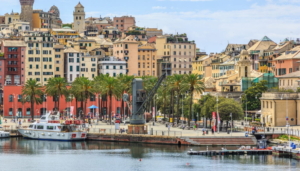
The Old Port
Genoa: the Maritime Republic where the spirit of Christopher Columbus and Niccolò Paganini echo through its timeless labyrinth of medieval streets.
Genoa is a city like no other — rising vertically between the sea and the mountains, it seems almost carved into the rugged landscape. Its geography has shaped its character: the historic center stretches along the narrow coastal plain, but quickly climbs up steep hills, creating a city of multiple levels stacked one above the other.
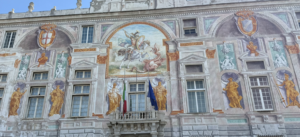
Palace of St. George, headquarters of the Port System Authority of the Western Ligurian Sea
It was in this vibrant and restless world that Christopher Columbus was born and grew up, walking the same shaded alleys and gazing out at the same bustling harbor that fueled his dreams of faraway lands. His modest childhood home still stands, a few steps from the ancient gates of the city.
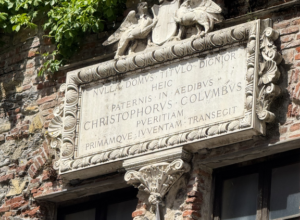
Christopher Columbus’ childhood home
The historic centre is recognized as a UNESCO World Heritage Site. It is a treasure trove waiting to be explored — a place where every step reveals a new wonder, narrow alleys and small squares cling to the slopes, while ancient staircases, hidden passageways, and dramatic inclines connect the lower and upper parts.
Above the Old Port area, you’ll find a network of creuze — steep, cobbled paths that snake their way uphill, offering breathtaking views of the sea. In some places, elevators and funiculars were built to help residents move between the different elevations, giving Genoa a unique vertical dynamic that still defines its daily life.
In 1992, to celebrate the 500th anniversary of Columbus’s first voyage, the Old Port area was completely transformed thanks to a visionary project by archistar Renzo Piano, who reimagined the waterfront while honoring its maritime roots.
Genoa’s historic centre is not a polished postcard — it is raw, lived-in, and irresistibly real.
As you wander through the ancient caruggi, you’ll notice peeling facades, worn stone walls, and overhead cables crisscrossing the narrow alleys. Time has left its mark everywhere, giving the city an atmosphere of authentic decay that feels both gritty and fascinating.
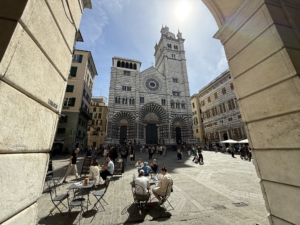
The cathedral of Saint Lawrence
Walking through Genoa means constantly changing perspective — from shadowy medieval alleys to sunlit terraces, from crowded markets by the sea to quiet, panoramic promenades high above the city
This unfiltered charm is part of what makes Genoa so unique: a place where history hasn’t been cleaned up and where life continues, layered over centuries of stories.
Genoa, once a powerful Maritime Republic, stood alongside Venice, Pisa, and Amalfi as an independent city-state that, between the 10th and 13th centuries, built its wealth and influence through naval trade and seafaring prowess. With a long-standing tradition of commerce — especially with the Levant — and financial expertise recognized across Europe, Genoa became not only a hub of international trade but also a center of sophisticated banking. Much of this fortune, though not widespread among the population, was concentrated in the hands of a tight-knit circle of banker-financiers — the true capitalists of their time — whose discreet power once shaped the destiny of empires.
This legacy is still visible today in the city’s grand architecture, particularly along Strada Nuova (now Via Garibaldi) and Via Balbi, where anyone strolling past the majestic palaces can feel the presence of immense wealth. These palaces were part of a system, the Palazzi dei Rolli, an original example of a public network of private residences designated to host state visits. “Rolli” refers to official lists of prestigious palaces designated to host dignitaries during state visits: a system of ‘public lodging’ in private residences, as decreed by the Senate in 1576. The term “Rolli” itself translates to “rolls” or “lists” in Italian, reflecting the documents used to keep track of these palaces.
For classical music lovers, it’s impossible to overlook that Genoa was the birthplace of Niccolò Paganini, the legendary 19th-century violin virtuoso whose dazzling technique and dramatic flair revolutionized classical music. His legacy still resonates through the city — quite literally — as his beloved violin, Il Cannone, is preserved and displayed in Palazzo Tursi.
Would you like to join me in discovering Genoa?
This immersive experience is a vibrant blend of history, architecture, art, music, and — of course — food. As we explore the winding alleys and majestic palaces of this former Maritime Republic, we’ll uncover stories of powerful bankers, visionary artists, and musical legends like Niccolò Paganini.
And no visit to Genoa would be complete without indulging in its culinary treasures. From the world-famous pesto to the golden, fragrant focaccia, and the delicious farinata — a crispy chickpea flatbread — you’ll enjoy an authentic taste of Ligurian tradition.
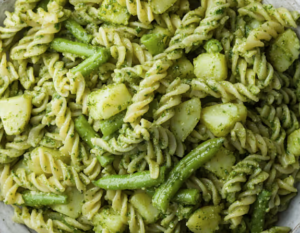
Pasta alla Genovese: fusilli with Pesto, green beans and potatoes

Genovese focaccia
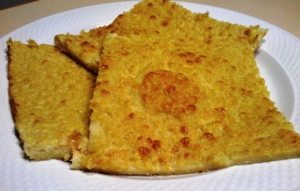
Genovese farinata — a crispy chickpea flatbread
Come experience Genoa with all five senses. It’s not just a tour — it’s a journey through the soul of the city.
For further information, please contact me.



